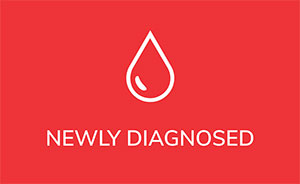Dr. John Allan is a CLL specialist at Weill Cornell in New York City who focuses on Richter’s Transformation, also called Richter’s Syndrome. He works with Dr. Rick Furman.
He is researching perhaps the greatest unmet needs for chronic lymphocytic leukemia patients, a better understanding of Richter’s Transformation (RT) in an effort to develop better ways to treat it.
My December ASH 2019 interview from Orlando, Florida with Dr. Allan is a good example of how knowing the basic science behind the biology of RT may lead to improved ways to predict it and maybe control it.
For more basic background on Richter’s, please see this article by Dr. Wiestner.
Dr. Allan and I also discussed an important class of medications, called ADC conjugates that have not been used to treat CLL, but are very big news in other lymphomas and have a role in treating RT.
Let’s walk through this:
Takeaways:
- Richter’s Transformation or Richter’s Syndrome is when our normally slow growing or indolent CLL transforms or changes into an aggressive fast-moving lymphoma, usually diffuse large B cell lymphoma (DLBCL) that carries a poor prognosis.
- Fortunately, this only occurs in about 10% of CLL patients but is becoming a bigger issue as we are living longer with our chronic lymphocytic leukemia.
- There are many known risk factors for developing Richter’s including NOTCH1 mutations, CD38+, and TP53 mutations. Prior chemotherapy also increases the risk.
- Seeing as RT may be a result of accumulating mutations in CLL, there is an argument to be made that earlier intervention in high risk CLL might make sense before the transformation occurs. This is only conjecture at this point and the standard of care remains watch and wait.
- The surface marker CD79b is part of the critically important B cell receptor (BCR) and turns out to highly expressed in most Richter’s patients, providing a potential attractive target.
- ADC or antibody drug conjugates are monoclonal antibodies that carry a payload of a toxic anti-cancer drug directly to the cells that they target and bind to.
- Polatuzumab vedotin is an anti-CD79b ADC that carries monomethyl auristatin E (MMAE) that potently kills cells but it too toxic to be given on its own. Polatuzumab vedotin has been approved to treat relapsed or refractory diffuse large B-cell lymphoma (DLBCL) that arises on its own, but has not yet been studied in RT.
- Even when all the Richter’s cells don’t express CD79b and therefore are not targeted by polatuzumab vedotin, it is still potentially very effective due to its ability to kill cells in close proximity to its target.
Summary:
The successes in treating chronic lymphocytic leukemia have laid bare the desperate need to develop better options for Richter’s.
We discuss several efforts in past interviews and promising research going back 5 years now including this from Dr. Wang on the role of transplants, this from Dr. Pagel on checkpoint inhibitors, this from Dr. Davids on adding venetoclax to a powerful chemo cocktail.
Now Dr. Allan thinks there may be reasons to question the dogma of waiting to treat and there may be a new marker to target in RT.
Here is my ASH 2019 interview with Dr. John Allan:
Here is his ASH abstract: CD79b Expression in Richter’s Transformation.
Stay strong, we are all in this together.
Brian Koffman

















